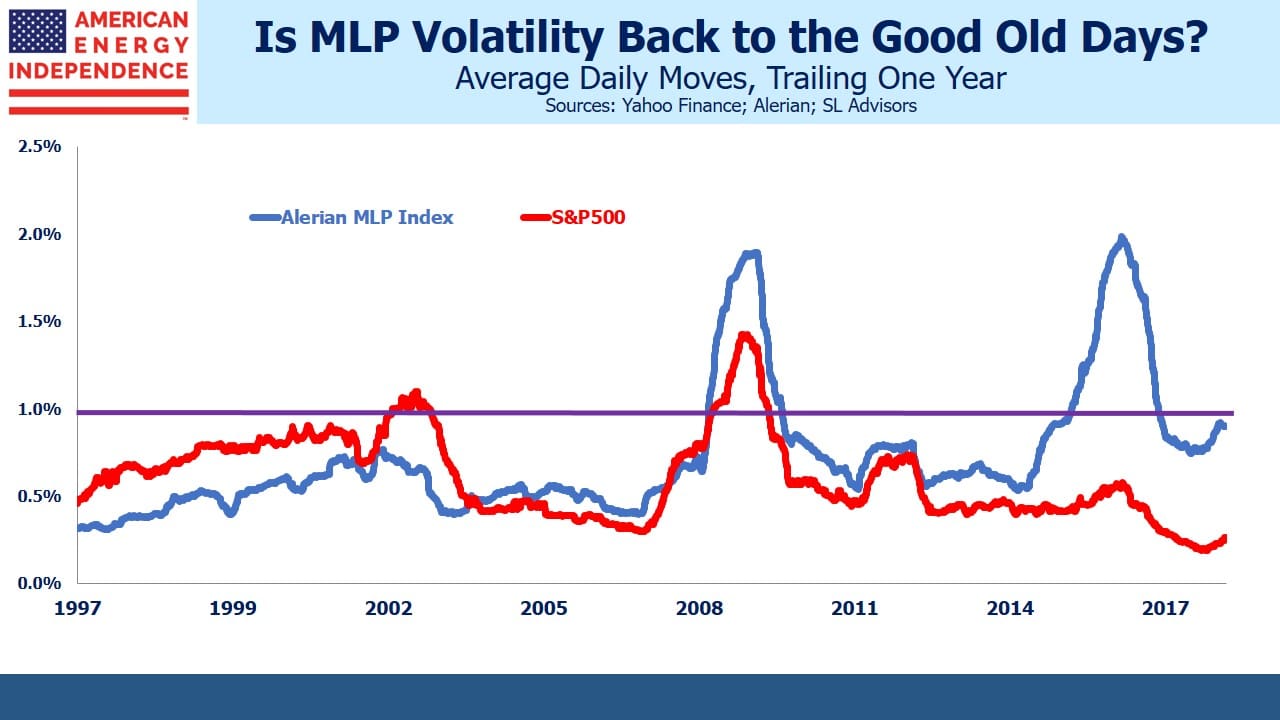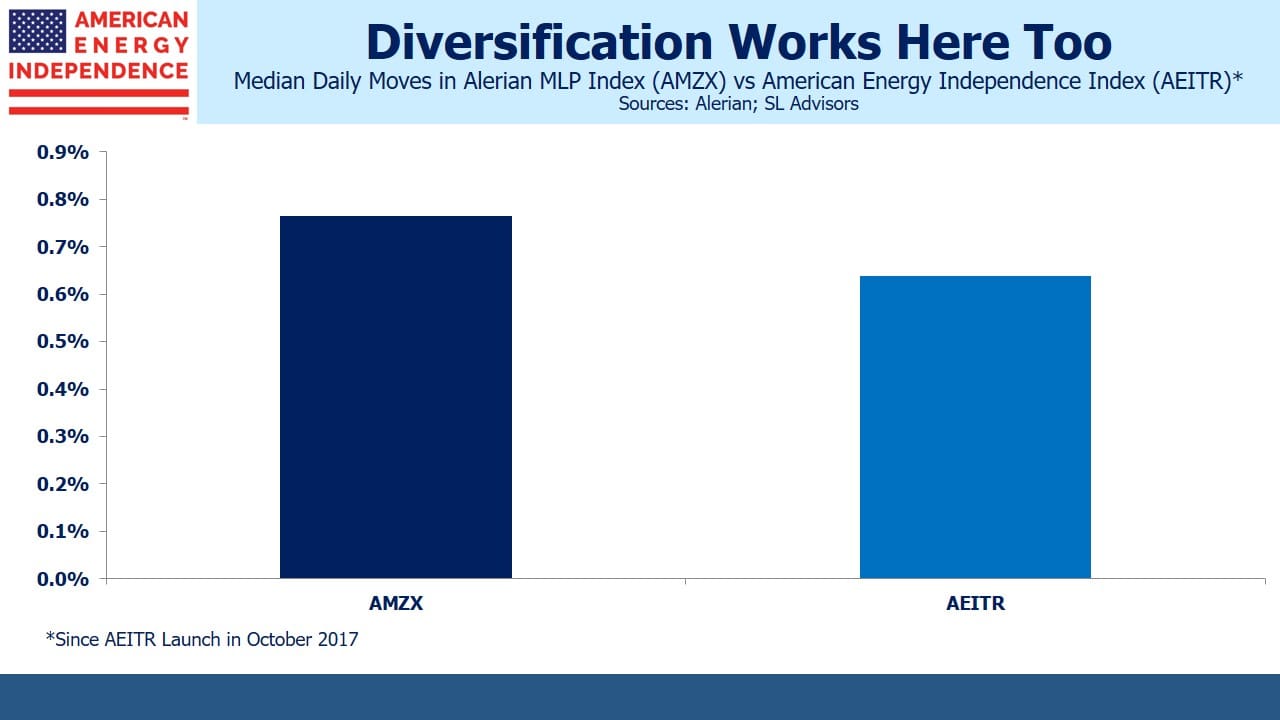Energy Infrastructure Stability Should Encourage More Buying
Volatility is not the investor’s friend. Some will immediately take issue with this – volatility caused by falling prices can mean opportunity, and volatile rising prices are surely welcome. While true, investments that gyrate cause investor stress which often leads to poorly timed sell decisions. Although a company’s long-term profitability should be more important, the downside of liquid equity markets is that they offer a constant evaluation of your decisions.
For many years before the Shale Revolution took hold, MLPs were known for stable, attractive yields. Companies paying out 90% of their Distributable Cashflow found income-seeking investors. This idyllic relationship suffered a nasty break-up once growth opportunities led to reduced distributions. Although justified, in order to lower leverage and fund new projects (see Will MLP Distribution Cuts Pay Off?), many investors felt betrayed.
As investors recall only too well, the result was a collapse in MLP prices bigger than occurred during the 2008 Financial Crisis. Midstream infrastructure businesses responded by strengthening balance sheets and, in many cases, converting to corporations. Older, wealthy Americans attracted to stable, tax-deferred MLP distributions are a poor match for growth businesses. The narrowness of the investor base, combined with uncertainty over how FERC will implement its revised policies on cost of service pipeline contracts (see FERC Ruling Pushes Pipelines Out of MLPs), have convinced most of the biggest energy infrastructure companies to organize as corporations. This makes their stock available to a far wider set of buyers.
For years, MLP prices were roughly as volatile as the S&P500. This relationship broke down in 2014 when the Energy sector endured its own bear market, leading to substantial performance divergence between the two.
But there are signs that the lower volatility of the past is returning. Companies are continuing to reduce leverage. 4X Debt/EBITDA (Earnings Before Interest, Taxes, Depreciation and Amortization) is now preferred to 5X. Financing of growth projects is far less reliant on issuing public equity. Distribution coverage is going up, even at the near term expense of distribution growth. Enterprise Products Partners (EPD) last year told investors to expect slower distribution hikes so they could redirect cash towards attractive projects. It’s worth noting that the high volatility of 2016 (defined as average daily moves of >1% over the prior year) is historically rare, occurring only 8% of the time since 1996.
Perhaps most importantly, the shift to a corporate structure is dramatically broadening the investor base, and this added stability is further reducing the sector’s volatility. The American Energy Independence Index provides broad exposure to North American energy infrastructure, with 80% corporations and only 20% in the biggest MLPs . It has 16% less volatility than the Alerian MLP Index, a meaningful improvement.
Given the well-established trend of larger MLPs to convert to corporations, this metric is likely to continue pointing away from an MLP-focused approach to the sector. As volatility returns to the lower levels that have predominated over the past 20-odd years, it’s likely that returns will also improve.
Important Disclosures
The information provided is for informational purposes only and investors should determine for themselves whether a particular service, security or product is suitable for their investment needs. The information contained herein is not complete, may not be current, is subject to change, and is subject to, and qualified in its entirety by, the more complete disclosures, risk factors and other terms that are contained in the disclosure, prospectus, and offering. Certain information herein has been obtained from third party sources and, although believed to be reliable, has not been independently verified and its accuracy or completeness cannot be guaranteed. No representation is made with respect to the accuracy, completeness or timeliness of this information. Nothing provided on this site constitutes tax advice. Individuals should seek the advice of their own tax advisor for specific information regarding tax consequences of investments. Investments in securities entail risk and are not suitable for all investors. This site is not a recommendation nor an offer to sell (or solicitation of an offer to buy) securities in the United States or in any other jurisdiction.
References to indexes and benchmarks are hypothetical illustrations of aggregate returns and do not reflect the performance of any actual investment. Investors cannot invest in an index and do not reflect the deduction of the advisor’s fees or other trading expenses. There can be no assurance that current investments will be profitable. Actual realized returns will depend on, among other factors, the value of assets and market conditions at the time of disposition, any related transaction costs, and the timing of the purchase. Indexes and benchmarks may not directly correlate or only partially relate to portfolios managed by SL Advisors as they have different underlying investments and may use different strategies or have different objectives than portfolios managed by SL Advisors (e.g. The Alerian index is a group MLP securities in the oil and gas industries. Portfolios may not include the same investments that are included in the Alerian Index. The S & P Index does not directly relate to investment strategies managed by SL Advisers.)
This site may contain forward-looking statements relating to the objectives, opportunities, and the future performance of the U.S. market generally. Forward-looking statements may be identified by the use of such words as; “believe,” “expect,” “anticipate,” “should,” “planned,” “estimated,” “potential” and other similar terms. Examples of forward-looking statements include, but are not limited to, estimates with respect to financial condition, results of operations, and success or lack of success of any particular investment strategy. All are subject to various factors, including, but not limited to general and local economic conditions, changing levels of competition within certain industries and markets, changes in interest rates, changes in legislation or regulation, and other economic, competitive, governmental, regulatory and technological factors affecting a portfolio’s operations that could cause actual results to differ materially from projected results. Such statements are forward-looking in nature and involves a number of known and unknown risks, uncertainties and other factors, and accordingly, actual results may differ materially from those reflected or contemplated in such forward-looking statements. Prospective investors are cautioned not to place undue reliance on any forward-looking statements or examples. None of SL Advisors LLC or any of its affiliates or principals nor any other individual or entity assumes any obligation to update any forward-looking statements as a result of new information, subsequent events or any other circumstances. All statements made herein speak only as of the date that they were made. r
Certain hyperlinks or referenced websites on the Site, if any, are for your convenience and forward you to third parties’ websites, which generally are recognized by their top level domain name. Any descriptions of, references to, or links to other products, publications or services does not constitute an endorsement, authorization, sponsorship by or affiliation with SL Advisors LLC with respect to any linked site or its sponsor, unless expressly stated by SL Advisors LLC. Any such information, products or sites have not necessarily been reviewed by SL Advisors LLC and are provided or maintained by third parties over whom SL Advisors LLC exercise no control. SL Advisors LLC expressly disclaim any responsibility for the content, the accuracy of the information, and/or quality of products or services provided by or advertised on these third-party sites.
All investment strategies have the potential for profit or loss. Different types of investments involve varying degrees of risk, and there can be no assurance that any specific investment will be suitable or profitable for a client’s investment portfolio.
Past performance of the American Energy Independence Index is not indicative of future returns.




Leave a Reply
Want to join the discussion?Feel free to contribute!